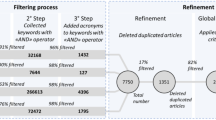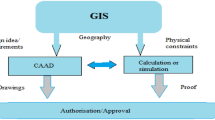Abstract
Determining whether an assembly can be constructed from its components at the design stage potentially reduces downstream assembly problems. This determination can be accomplished by performing a disassembly analysis of the assembly′s geometric model. This paper presents two abstractions derived from the assembly′s geometric model that can determine the validity of the assembly: (1) the Assembly Topology Graph (ATG); and (2) the set of boundary components. The first abstraction, the ATG, is a graph whose nodes represent the components in the assembly and whose edges represent a non-null intersection of the convex hulls of component pairs. The second abstraction, the set of boundary components, represents components that intersect the boundary (or convex hull) of the assembly. These boundary components are typically the ones most accessible with respect to disassembly. This paper also discusses an algorithm, which utilizes the ATG to determine pair-wise interlocking components. If such component pairs are absent, then the disassembly sequence for the removal of components in the assembly is determined by analyzing the set of boundary components for disassembly. This procedure is repeated until all the components in the assembly are disassembled (for a valid assembly).
Similar content being viewed by others
References
Homem DeMello, L.S. and Sanderson, A.C. (1991) Representations of mechanical assembly sequences. IEEE Transactions on Robotics and Automation, 7, 211–277.
Wilson, R.H. and Latombe, J.C. (1994) Geometric reasoning about mechanical assembly. Artificial Intelligence, 71(2), 1–31.
Mattikalli, R.S., Khosla, P.K. and Xu, Y. (1990) Subassembly identification and motion generation for assembly: a geometric approach. Proceedings of the 1990 IEEE International Conference on Systems Engineering, Pittsburgh, PA, IEEE, IEEE Service Center, Piscataway, NJ, 399–403.
Agarwal, P.K., Berg, M.D., Halperin, D. and Sharir, M. (1996) Efficient generation of k-directional assembly sequences, in Proceedings of the 7th ACM-SIAM Symposium on Discrete Algorithms, Atlanta, USA, 122–131.
Liu, Y. and Popplestone, R.J. (1989) Planning for assembly from solid models, in Proceedings of the IEEE International Conference on Robotics and Automation, Scottsdale, AZ, IEEE Service Center, Piscataway, NJ, Vol 1, pp. 222–227.
Goldwasser, M., Latombe, J.C. and Motwani, R. (1996) Complexity measures for assembly sequences, in Proceedings of the 13th IEEE International Conference on Robotics and Automation, Part 2, Minneapolis, MN, IEEE Service Center, Piscataway, NJ, pp. 1581–1587.
Mattikalli, R.S. and Khosla, P.K. (1992) Motion constraints from contact geometry: representation and analysis, in Proceedings of the IEEE International Conference on Robotics and Automation, Nice, France, IEEE Service Center, Piscataway, NJ, pp. 2178–2185.
Halperin, D. (1994) Assembly partitioning with a constant number of translations. Technical Report Sandia National Labs, SAND94–1819, 1–17.
[9] Chakrabarty, S. and Wolter, J. (1994) A hierarchical approach to assembly planning, in Proceedings of the IEEE International Conference on Robotics and Automation, San Diego, CA, IEEE Service Center, Piscataway, NJ, pp. 258–263.
Woo, T.C. and Dutta, D. (1991) Automatic disassembly and total ordering in three dimensions. ASME Transactions Journal of Engineering for Industry, 13(2), May, 207–213.
Dutta, D. and Woo, A.C. (1992) Algorithms for multiple disassembly and parallel assemblies. Concurrent Engineering, 59, 257–266.
Beasley, D. and Martin, R.R. (1993) Disassembly sequences for objects built from unit cubes. CAD, 25, 751–761.
Shin, K. and Cho, H.S. (1994) On the generation of robotic assembly sequences based on separability and assembly motion stability. Robotica, 12, 7–15.
Xu, Y., Mattikalli, R. and Khosla, P. (1995) Generation of partial medial axis for disassembly motion planning. Journal of Design and Manufacturing, 5, 89–100.
Kroll, E., Beasley, B., Parulin, A. and Berners, D. (1994) Evaluating ease-of-disassembly for product recycling. ASME Materials and Design Technology, 62, 165–172.
Lowe, A.S. and Niku, S.B. (1995) A methodology for design for disassembly. ASME Design for Manufacturability, 81, 47–53.
Lee, K. and Gadh, R. (1996) Destructive disassembly to support virtual prototyping, IIE Transactions, 30(10), 959–972.
Requicha, A.A.G. and Whalen, T.W. (1991) Representations for assemblies. Computer-Aided Mechanical Assembly Planning, (L.S. Homen de Mello, (ed)), Kluwer Academic Publishers, Boston, MA, 15–39.
Turner, J.U. (1991) Relative positioning of parts in assemblies using mathematical programming. Computer Aided Mechanical Assembly Planning, (L.S. Homen de Mello, (ed)), Kluwer Academic Publishers, Boston, MA, 111–126.
Stoer, J. and Witzgall, C. (1970) Convexity and Optimization in Finite Dimensions I, Springer-Verlag, Berlin, Germany.
Chazelle, B. (1993) An optimal convex hull algorithm in any fixed dimension. Discrete & Computational Geometry, 10, 377–409.
Latombe, J.C. (1991) Robot Motion Planning, Kluwer Academic Publishers, Boston, MA.
Preparata, F.P. and Shamos, M.I. (1985) Computational Geometry, Springer-Verlag, New York, USA.
Kepler, A. (1987) Lower bound on the complexity of the convex hull problem for simple polyhedra. Information Processing Letters, 25, 159–161.
Muller, D.E. and Preparata, F.P. (1978) Finding the intersection of two convex polyhedra. SIAM Journal of Computing, 21, 671–696.
Stefan, H., Mantyala, M., Kurt, M. and Jurg, N. (1984) Space sweep solves intersection of convex polyhedra. Acta Informatica, 21, 501–519.
Dobkin, D. and Kirkpatrick, D.G. (1985) A linear algorithm for determining the separation of convex polyhedra. Journal of Algorithms, 6, 381–392.
Chazelle, B. (1992) An optimal algorithm for intersecting threedimensional convex polyhedra. SIAM Journal of computing, 21, 671–696.
Rights and permissions
About this article
Cite this article
Shyamsundar, N., Gadh, R. Geometric abstractions to support disassembly analysis. IIE Transactions 31, 935–946 (1999). https://doi.org/10.1023/A:1007619330337
Issue Date:
DOI: https://doi.org/10.1023/A:1007619330337




